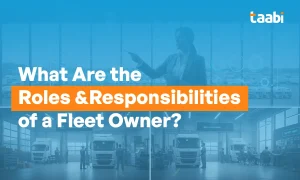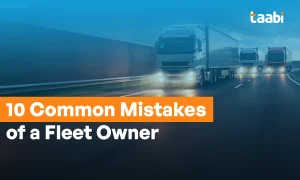Key Takeaways
- ➤The Roles and Responsibilities of a Fleet Owner include owning and managing multiple vehicles for logistics and transport.
- ➤Success depends on proactive maintenance, financial oversight, and efficient fleet management.
- ➤A driver fleet owner must balance driver safety and operational goals.
- ➤A small fleet owner benefits from scalability, flexibility, and resilience.
- ➤Becoming a fleet owner is a path toward business independence and long-term profitability.
Introduction
In India’s fast-growing logistics and transport sector, knowing the roles and responsibilities of a fleet owner is crucial for anyone managing trucks, vans, or delivery vehicles. A fleet owner ensures smooth movement of goods across states and cities — from factory gates to retail outlets — while balancing safety, profitability, and compliance.
Whether you’re a driver-fleet owner, a small fleet entrepreneur, or planning on becoming a fleet owner, understanding your core duties and risks will help you manage operations efficiently. With the increasing demand for last-mile and inter-state transport, mastering these responsibilities sets the foundation for long-term success and makes it one of the core activities in the Roles and Responsibilities of a Fleet Owner.
What Does a Fleet Owner Mean?
The fleet owner meaning refers to an individual or business that owns and operates multiple vehicles used for transportation or logistics services. These vehicles could include trucks, trailers, or delivery vans that are part of a larger logistics operation.
A fleet owner operator can either manage the vehicles themselves or employ drivers to handle daily operations. The goal is to ensure optimal vehicle utilization, minimize downtime, and maintain profitability through efficient fleet management.
In simpler terms, a fleet owner isn’t just about owning trucks; it’s about managing assets, people, and processes to ensure that every vehicle on the road contributes to the company’s success. So these all comprise the Roles and Responsibilities of a Fleet Owner.
Core Roles and Responsibilities of a Fleet Owner
1. Asset Acquisition & Management
A fleet owner operator is responsible for deciding when and what vehicles to buy or lease, ensuring the fleet supports operational goals, business growth, and regulatory compliance.
Poor planning can lead to inefficiency and added costs, while smart decisions drive long-term performance and profitability.
2. Vehicle Maintenance
A fleet owner operator is responsible for acquiring, financing, and maintaining all vehicles in the fleet. This includes creating preventive maintenance schedules, ensuring timely servicing, and keeping detailed maintenance records.
Neglecting these areas can lead to breakdowns, increased costs, and compliance issues. Smart fleet management platforms help monitor vehicle health, fuel usage, and performance metrics in real time.
3. Driver Management
Drivers are the backbone of every Indian fleet operation. Fleet owners must ensure driver training, proper rest breaks, and adherence to traffic norms.
Good communication between owners and drivers improves delivery timelines, reduces accidents, and promotes long-term retention — a key challenge in India’s trucking industry.
4. Financial Oversight
A successful fleet owner operator understands the financial side of the business — from calculating cost per kilometre, optimizing fuel expenses to payroll and contracts with vendors. Maintaining digital expense records simplifies GST filing and boosts profitability through better financial planning.
Every decision, from vehicle purchase to route planning, affects the bottom line.
Accurate budgeting and forecasting help in becoming a fleet owner who sustains profits while managing operational risks effectively.
5. Operational Optimization
Today, technology defines modern fleet management. Real-time telematics, GPS tracking, and route optimization software have become essential for monitoring performance and ensuring cost efficiency. Through advanced fleet management systems, they can reduce idle time, improve load utilization, and maximize profitability.
For every truck fleet owner, adopting technology is not optional; it’s the foundation for scaling and maintaining competitiveness in a fast-moving industry.

Major Benefits of Fleet Ownership
1. Scalable Income
2. Economies of Scale
3. Business Flexibility
Fleet ownership allows diversification. A small fleet owner can operate in multiple logistics segments, from perishable goods to bulk materials, depending on demand. This flexibility helps maintain steady revenue even when certain industries slow down.
4. Reduced Downtime Risk
5. Management-Leisure Balance
Challenges in Fleet Ownership
Despite the benefits, becoming a fleet owner comes with challenges such as driver shortages, fluctuating diesel prices, and compliance with e-way bill and FASTag norms. However, digital tools like Taabi’s intelligent fleet management solutions simplify tracking, reporting, and vehicle optimization, helping owners maintain control and efficiency.
Conclusion
The Roles and Responsibilities of a Fleet Owner go far beyond vehicle ownership — it’s about strategic management, financial control, and technological adoption. Whether you’re a driver fleet owner managing a few vehicles or a small fleet owner scaling your logistics business, understanding your responsibilities ensures long-term success.
At Taabi, intelligent fleet management solutions empower the Roles and Responsibilities of a Fleet Owner to reduce downtime, improve efficiency, and gain full control over their operations , redefining what it truly means to be a fleet owner in today’s connected world.








